
Bran becoming the Three-Eyed Raven is a confusing, yet integral aspect of Game of Thrones’ story, but what was the identity of Bran’s predecessor?
Game of Thrones leaves a lot of mysteries unresolved including the question of who the Three-Eyed Raven was. Bran’s Three-Eyed Raven predecessor was the last greenseer human living beyond the Wall with the Children of the Forest. Portrayed by Max von Sydow in season 6, the Three-Eyed Raven guides Bran Stark to the cave where his human body lives before teaching him the wisdom that comes with their gifts. The Three-Eyed Raven reveals he has lived for over a thousand years, though has had many predecessors who also passed down the magic of greensight. However, one thing not revealed is the answer to who the Three-Eyed Raven originally was.
While the show never explores his identity, the books, which refer to the greenseer as the Three-Eyed Crow, suggest that he was actually Brynden Rivers, a Great Targaryen Bastard. The crow says he was once a lord named Brynden, and the only notable Brynden in his corresponding timeline and details would have been the bastard son of Aegon IV Targaryen. He also mentioned he had a woman he desired, a brother he loved, and a brother he hated, all of which match up with Brynden Rivers’ background. All this happened way before Game of Thrones’ timeline. In fact, Brynden Rivers’ great-grandmother and grandfather are House of the Dragon’s Rhaenyra and Daemon Targaryen.
The Three-Eyed Raven Was A Targaryen Bastard
Although the question of who is the Three-Eyed Raven is not confirmed, Brynden Rivers is a strong candidate. Brynden was the bastard son of Rhaenyra and Daemon’s grandson, King Aegon IV — by Aegon IV’s sixth mistress, Lady Melissa Blackwood, and since his mother was also high-born, he gained the title of a Great Bastard. Brynden was legitimized by his father in 184 AC, along with his other bastard siblings like Aegor Rivers who went on to find the Golden Company. He held many titles including Hand of the King to Aerys I and Maekar I, though was banned to the Night’s Watch by Aegon V.
The brother he hated was Aegon Rivers, the woman he admired was his half-sister Sheira, and the brother he loved was King Daeron II. About 50 years after the House of the Dragon timeline, Brynden’s earliest nickname was “Lord Bloodraven,” after a birthmark on his cheek that looked like a raven drawn in blood. His group of personal guards were also referred to as Raven’s Teeth, many of whom followed him in taking the black.

While holding his title as Hand of the King, he also served as master of whisperers, which was attributed to having his “little crows” and many eyes, though more aptly due to his greensight. Brynden ended up becoming Lord Commander of the Night’s Watch in 239 AC, though went missing 13 years later on a raging trip beyond the Wall, which is when the theory indicates he stayed to become the Three-Eyed Raven.
Game of Thrones’ backstory details on the Three-Eyed Raven doesn’t exactly align with the history of House Targaryen in the novels, as the Three-Eyed Raven has lived for a thousand years and Brynden was born in 175 AC, only 125 years before A Dance With Dragons takes place. That said, it could be that the Three-Eyed Raven was saying that the title has existed for over 1000 years – passed on to each new generation – consistent with how gaining the title changed Bran’s perspective. Either way, the connections between Brynden Rivers and Game of Thrones’ Three-Eyed Raven can’t just be coincidental.
HotD’s White Walker Prophecy Could Explain The Three-Eyed Raven’s Targaryen Link
House of the Dragon may have offered more evidence in the “who is the Three-Eyed Raven” mystery as the Song of Ice and Fire prophecy was revealed to be Aegon’s dream, and that the revelation has been passed down from Targaryen to Targaryen. This means that the family knew of HotD’s upcoming White Walker threat, and it explains why they fought so hard to keep the line on the throne considering the dragons are their only apparent defense against the White Walkers. However, the Targaryens are a cunning house, and they will’ve known that the dragons couldn’t have been their only way to counter the Night King.
Sending Brynden to the Wall would’ve accomplished two things for the dragons. The first is that it will’ve been a defensive force from the northmost point of Westeros. Having the Three-Eyed Raven there would’ve meant that any upcoming attacks would have been foreseen, and proper preparations could be made. The other accomplishment would be promptly removing a bastard from the family. House of the Dragon’s Targaryen treatment of bastards is quite dire, and the latest prophecies from the show only lend credence to Game of Thrones’ Brynden theory.
A HotD Link Would Make The Night King’s Hatred Deeper
The Three-Eyed Raven being a descendant of House of the Dragon’s Targaryens will underscore how the Night King hated the Three-Eyed Raven because he is “the memory of the world” — the two have not only known but also fought each other in the near and distant past. The living archive of Westeros’ collective memory, the Three-Eyed Raven knew exactly what the Night King was and how to defeat him, and was the only one capable of warning the continent of the White Walkers’ impending attack.
Confirming a link between the two shows via the Three-Eyed Raven will make the Night King’s determination to kill him — and Bran Stark — incredibly deeper to watch when re-watching Game of Thrones. Like the blade Arya used to kill the Night King with — House of the Dragon’s catspaw dagger (which also secretly contained Aegon’s prophecy) — the Three-Eyed Raven actually being Brynden Rivers ultimately strengthens the link between House Targaryen and the White Walkers.
Game of Thrones, until the very end, notably remains vague in terms of tackling prophecy. With the prequel series filling in the blanks, however, House of the Dragon season 2 could reveal more about the Three-Eyed Raven and Brynden Rivers as the series climbs further down the House Targaryen family tree.
Does The Identity Of The Three-Eyed Raven Even Really Matter?
While the question of who the Three-Eyed Raven was an interesting one, it ultimately doesn’t matter in Game of Thrones because the character does not matter. Certainly, he should be a big deal as he is a powerful being with untold knowledge who could reveal all the secrets of Westeros but in the end, he was yet another big idea from George R.R. Martin’s books that the should didn’t know what to do with. While it felt like he came and went so quickly that a backstory would have helped make him more memorable, by the end of Game of Thrones, everything the Three-Eyed Raven introduced to the show ended up being meaningless.
He was the most powerful being in Westeros yet nobody knew he ever existed. The Night King wanted to kill him to prevent him from sharing Westeros’ history, but there was no one to share it with. Even his powers proved inconsequential. He helped reveal two seemingly big secrets with the origins of the Night King and Jon Snow’s true parentage, neither of which had an impact on the story. His real purpose was apparently to transfer his powers to Bran but even that didn’t have a major payoff (although it did help take down Littlefinger). Bran’s abilities don’t even factor into him being named as king. It is hard to imagine what impact there would be to the story if the Three-Eyed Raven simply didn’t exist.
